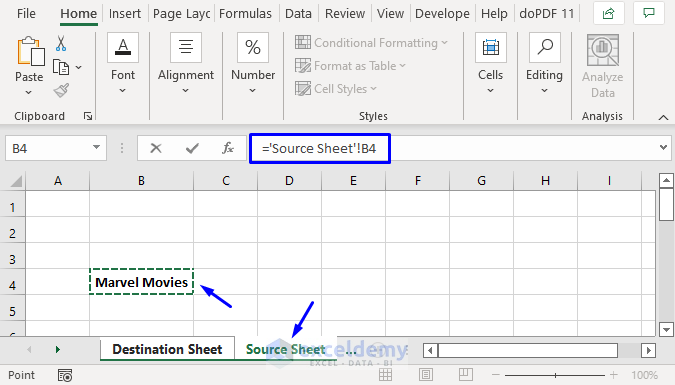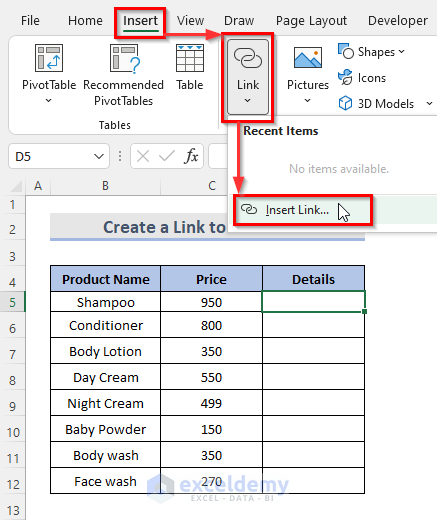5 Ways to Link Excel Sheets Efficiently

Linking Excel sheets can significantly enhance productivity, especially when working with large datasets or complex projects that require data to be updated and reflected across multiple sheets. Whether you're a data analyst, financial planner, or just a meticulous Excel enthusiast, mastering the art of linking sheets can streamline your workflow. Here are five efficient ways to link Excel sheets, ensuring seamless data integration and ease of data management.
1. External References (Links) for Dynamic Updates

External references or links allow you specific cells, ranges, or even entire sheets from one workbook into another. This method is particularly useful for:
- Summarizing data from multiple workbooks into a master sheet.
- Ensuring real-time updates across linked documents.
To use external references:
- Open both workbooks: The source and the destination.
- Select the cell where you want to place the link in the destination workbook.
- Enter
=[WorkbookPath]SheetName!CellAddressreplacingWorkbookPathwith the full path or a common link to the source workbook.
💡 Note: Ensure that the source file is accessible and not moved or renamed, or the link will break.
2. Use of Named Ranges for Clarity and Mobility

Named Ranges make your formulas much more readable and maintainable. Here’s how you can link sheets using named ranges:
- Define a Named Range:
- In the source workbook, select the range you want to name.
- Go to Formulas > Define Name, and give it a clear name.
- Link Using the Name:
- In the destination workbook, simply reference the named range as =[WorkbookName]!NamedRange.
🧠 Note: Named ranges can be updated to reflect changes in data locations, making them versatile for ongoing projects.
3. 3D References for Summarizing Data Across Sheets

3D References are perfect for when you need to perform calculations or data aggregation across several sheets:
- To sum data across sheets, use a formula like
=SUM(Sheet1:Sheet10!A1)where A1 is the cell you want to sum across sheets. - This method works best when the sheets are in the same workbook and you want to analyze the same cell across multiple sheets.
📋 Note: Ensure all referenced sheets have the same structure to avoid errors.
4. Power Query for Advanced Data Linking

Power Query, available in Excel 2016 and later versions, provides a robust way to link and transform data:
- Get Data > From File > From Workbook and select your source Excel file.
- Import the required tables or sheets.
- Use Power Query Editor to transform or consolidate data before loading it into your destination workbook.
This method allows for:
- Dynamic refresh of data with a single click.
- The ability to combine data from multiple sources, not just Excel.
🛠️ Note: Advanced knowledge of Power Query might be necessary for complex transformations.
5. Using VBA for Custom Link Creation and Maintenance

For those comfortable with Excel’s programming side, Visual Basic for Applications (VBA) offers custom solutions for linking sheets:
- Open the VBA Editor by pressing Alt + F11.
- Insert a new module and write or adapt code to manage links:
Sub LinkSheets() Dim ws As Worksheet Set ws = Workbooks(“SourceWorkbook.xlsx”).Sheets(“Sheet1”) ThisWorkbook.Sheets(“Sheet2”).Range(“A1”).Value = ws.Range(“B2”).Value End Sub - Run the macro to link sheets as needed.
🔧 Note: VBA can automate repetitive tasks but requires some initial setup and programming knowledge.
In summary, linking Excel sheets efficiently can transform your data management practices. By employing external references, named ranges, 3D references, Power Query, or even VBA, you can achieve a level of integration and automation that makes handling extensive datasets easier. Whether you're performing data analysis, financial reporting, or just need to keep your data synchronized across multiple documents, these methods ensure your work is efficient and error-free.
What happens if the source file is moved or renamed?

+
If the source file is moved or renamed, links will break. Ensure the file’s location is stable or update the link references manually or through VBA if changes are necessary.
Can I link data from multiple sheets in a workbook to one summary sheet?

+
Yes, using 3D references or Power Query can help aggregate data from multiple sheets into a single summary sheet, providing an overview or consolidation of data.
Is there a way to update linked data automatically?

+
Automatically updated links can be set up via VBA for custom solutions or by using Power Query with data refresh settings enabled for periodic updates.



